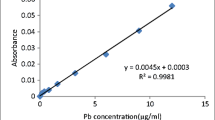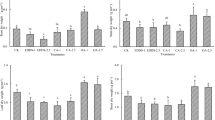Abstract
Phytoremediation is an in situ, low-cost strategy for cleanup of the sites contaminated with heavy metals. Experiments were conducted to assess the impact of synthetic chelators and plant growth-promoting rhizosphere bacteria (Herbaspirillum sp. GW103) on heavy metal lead (Pb) uptake in Z. mays cultivated in Pb-contaminated soil. The present study investigated the Pb phytoaccumulation rate and plant antioxidant enzyme activities in Z. mays exposed to 100 mg/kg of PbNO3. The combination of gluconic acid (GA) with Herbaspirillum sp. GW103 treatment showed higher Pb solubility (18.9 mg/kg) compared with other chelators. The chemical chelators showed the significant difference in phytoaccumulation as well as antioxidant enzyme activities. The antioxidant enzymes such as catalase, peroxidase and superoxide dismutase activities changed under Pb stress. The study indicated that increased activity of antioxidant enzymes may play as signal inducers to fight against Pb.


Similar content being viewed by others
References
Apel K, Hirt H (2004) Reactive oxygen species: metabolism, oxidative stress, and signal transduction. Annu Rev Plant Biol 55:373–399
Baker AJM, McGrath SP, Reeves RD, Smith JAC (2000) Metal hyperaccumulator plants: a review of the ecology and physiology of a biological resource for phytoremediation of metal-polluted soils. In: Terry N, Bañuelos G (eds) Phytoremediation of contaminated soil and water. CRC Press LLC, USA, pp 85–107
Castillo FI, Penel I, Reppin H (1984) Peroxidase release induced by ozone in sedum album leaves. Plant Physiol 74: 846–851
Chandra R, Yadav S (2010) Potential of Typha angustifolia for phytoremediation of heavy metals from aqueous solution of phenol and melanodin. Ecol Eng 36:1277–1284
Chandra R, Yadav S (2011) Phytoremediation of Cd, Cr, Cu, Mn, Fe, Ni, Pb and Zn from aqueous solution using Phragmites cummunis, Typha angustifolia and Cyperus esculentus. Int J Phytorem 13:580–591
Dhindsa RS, Plumb-Dhindsa P, Thorpe TA (1981) Leaf senescence correlated with increased levels of membrane permeability and lipid peroxidation and decreased levels of superoxide disniutase and catalase. J Exp Bot 32:93–101
Epstein AL, Gussman CD, Blaylock MJ, Yermiyahu U, Huang JW, Kapulnik Y, Orser CS (1999) EDTA and Pb–EDTA accumulation in Brassica juncea grown in Pb-amended soil. Plant Soil 208:87–94
Evangelou MWH, Ebel M, Schaeffer A (2007) Chelate assisted phytoextraction of heavy metals from soil effect, mechanism, toxicity, and fate of chelating agents. Chemosphere 68:989–1003
Foyer CH, Lelandais M, Kunert KJ (1994) Photooxidative stress in plants. Physiol Plant 92:696–717
Gallego SM, Benavides MP, Tomaro ML (1999) Effect of cadmium ions on antioxidant defence system in sunflower cotyledons. Biol Plant 42:4955
Govarthanan M, Lee KJ, Cho M, Kim JS, Kamala-Kannan S, Oh B-T (2013) Significance of autochthonous Bacillus sp. KK1 on biomineralization of lead in mine tailings. Chemosphere 90:2267–2272
Govarthanan M, Lee GW, Park JH, Kim JS, Lim SS, Seo SK, Cho M, Myung H, Kamala-Kannan S, Oh BT (2014) Bioleaching characteristics, influencing factors of Cu solubilization and survival of Herbaspirillum sp. GW103 in Cu contaminated mine soil. Chemosphere 109:42–48
Govarthanan M, Park SH, Park YJ, Myung H, Krishnamurthy RR, Lee SH, Lovanh N, Kamala-Kannan S, Oh BT (2015a) Lead biotransformation potential of allochthonous Bacillus sp SKK11 with sesame oil cake extract in mine soil. RSC Adv 5:54564
Govarthanan M, Shim J, Kim SA, Kamala-Kannan S, Oh BT (2015b) (b). Isolation and characterization of multi-metal resistant Halomonas sp. MG from Tamil Nadu magnesite ore soil in India. Curr Microbiol 71:618–623
Halliwell B (1982) The toxic effects of oxygen on plant tissues. In: Oberley LW (ed) Superoxide Dismutase, vol I. CRC Press, Boca Raton, pp 89–123
Huang JW, Chen J, Berti WR, Cunningham SD (1997) Phytoremediation of lead contaminated soils: role of synthetic chelates in lead phytoextraction. Environ Sci Technol 3:800–805
Inze D, Van-Montagu M (1995) Oxidative stress in plants. Curr Opin Biotechnol 6:153–158
Kos B, Lestan D (2004) Chelator induced phytoextraction and in situ soil washing of Cu. Environ Pollut 132:333–339
Lee GW, Lee KJ, Chae JC (2012) Genome sequence of Herbaspirillum sp. strain GW103, a plant growth promoting bacterium. J Bacteriol 194:4150
Liu D, Islam E, Li T, Yang X, Jin X, Mahmood Q (2008) Comparison of synthetic chelators and low molecular weight organic acids in enhancing phytoextraction of heavy metals by two ecotypes of Sedum alfredii Hance. J Hazard Mater 153:114–122
Lombi E, Zhao FJ, Dunham SJ, McGrath SP (2001) Phytoremediation of heavy metal-contaminated soils: natural hyperaccumulation versus chemically enhanced phytoextraction. J Environ Qual 30:1919–1926
Luo CL, Shen ZG, Li XD, Baker AJM (2006) Enhanced phytoextraction of Pb and other metals from artificially contaminated soils through the combined application of EDTA and EDDS. Chemosphere 63:1773–1784
Meers SE, Qadir M, de Caritat P, Tack FMG, Du Laing G, Zia MH (2009) EDTA-assisted Pb phytoextraction. Chemosphere 74(2009):1279–1291
Mittler R, Vanderauwera S, Gollery M, Van-Breusegem F (2004) Reactive oxygen gene network of plants. Trends Plant Sci 9:490–498
Nehnevajova E, Lyubenova L, Herzig R, Schroder P, Schwitzguebel JP, Schmulling T (2012) Metal accumulation and response of antioxidant enzymes in seedlings and adult sunflower mutants with improved metal removal traits on a metal-contaminated soil. Environ Exp Bot 76:39–48
Ok YS, Kim SC, Kim DK, Skousen JG, Lee JS, Cheong YW, Kim SJ, Yang JE (2011) Ameliorants to immobilize Cd in rice paddy soils contaminated by abandoned metal mines in Korea. Environ Geochem Health 33:23–30
Piero F, Lorenzo P, Giovanni B (1980) Use of 3, 5-dichloro-2-hydroxybenzenesulfonic acid/4-aminophenazone chromogenic system in direct enzymic assay of uric acid in serum and urine. Clin Chem 26:227–231
Quartacci MF, Argilla A, Baker AJM, Navari-Izzo F (2006) Phytoextraction of metals from a multiply contaminated soil by Indian mustard. Chemosphere 63:918–925
Ramachandran S, Fontanille P, Pandey A, Larroche C (2006) Gluconic acid: properties, applications and microbial production. Food Technol Biotechnol 44:185–195
Romkens P, Bouwman L, Japenga J, Draaisma C (2002) Potentials and drawbacks of chelate-enhanced phytoremediation of soils. Environ Pollut 116:109–121
Salin ML (1987) Toxic oxygen species and protective systems of the chloroplast. Physiol Plant 72:681–689
Saravanan VS, Kalaiarasan P, Madhaiyan M, Thangarju M (2007) Solubilization of insoluble zinc compounds by Gluconacetobacter diazotrophicus and the detrimental action of zinc ion (Zn2+) and zinc chelates on root knot nematode Meloidogyne incognita. Lett Appl Microbiol 44:235–241
Sauer M, Porro D, Mattanovich D, Branduardi P (2008) Microbial production of organic acids: expanding the markets. Trends Biotechnol 26:100–108
Shen ZG, Li XD, Wang CC, Chen HM, Chua H (2002) Lead phytoextraction from contaminated soil with high biomass plant species. J Environ Qual 31:1893–1900
Shin MN, Shim J, You Y, Myung H, Bang KS, Cho M, Kamala-Kannan S, Oh BT (2012) Characterization of lead resistant endophytic Bacillus sp. MN3-4 and its potential for promoting lead accumulation in metal hyperaccumulator Alnus firma. J Hazard Mater 199–200:314–320
Vassil AD, Kapulnik Y, Raskin I, Salt DE (1998) The role of EDTA in lead transport and accumulation in Indian mustard. Plant Physiol 117:447–544
Wu LH, Luo YM, Xing XR, Christie P (2004) EDTA-enhanced phytoremediation of heavy metal contaminated soil with Indian mustard and associated potential leaching risk. Agric Ecosyst Environ 102:307–318
Yang JE, Ok YS, Kim WI, Lee JS (2008) Heavy metal pollution, risk assessment and remediation in paddy soil environment: research and experiences in Korea. In: Sanchez ML (ed) Cause and effects of heavy metal pollution. Nova Science Publishers, New York
Zhuang P, Yang QW, Wang HB, Shu WS (2007) Phytoextraction of heavy metals by eight plant species in the field. Water Air Soil Pollut 184:235–242
Acknowledgments
This work was supported by the BK21 plus program through the National Research Foundation (NRF)funded by the Ministry of Education of Korea.
Author information
Authors and Affiliations
Corresponding authors
Additional information
Communicated by Erko Stackebrandt.
Rights and permissions
About this article
Cite this article
Govarthanan, M., Kamala-Kannan, S., Kim, S.A. et al. Synergistic effect of chelators and Herbaspirillum sp. GW103 on lead phytoextraction and its induced oxidative stress in Zea mays . Arch Microbiol 198, 737–742 (2016). https://doi.org/10.1007/s00203-016-1231-7
Received:
Revised:
Accepted:
Published:
Issue Date:
DOI: https://doi.org/10.1007/s00203-016-1231-7




